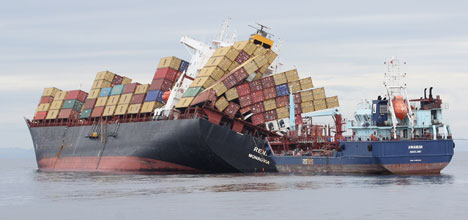Salvors are continuing to pump oil from the stricken cargo ship Rena today with almost a third of the oil being removed from the ship since it ran aground on October 5.
A total of 481 tonnes of oil has been pumped from the ship's port number five tank, which originally held 772 tonnes onto the barge vessel Awanuia.
This leaves approximately 870 tonnes in the ship, held in four different tanks.
A third of the oil on board the stricken container ship Rena grounded on Astrolabe Reef has been removed from the ship.
Maritime New Zealand salvage unit manager Bruce Anderson says two booster pumps installed on Sunday, October 23 has sped up the pumping rate from the port tank, and Svitzer's salvage teams were continuing to work on ways to extract oil from the submerged starboard tank and two settling tanks in the engine room.
The salvors loaded more equipment on the ship yesterday afternoon, including a lighting system.
'This is important, because they have been working in dark, oily corridors, which is clearly risky and challenging.
'The lighting will make the working environment safer for the teams on board. They have also loaded heavy duty compressors to aid the pumping system.”
MNZ national on-scene commander Rob Service says planning teams were continuing to track the movement of between five and 10 tonnes of oil that leaked from the ship on Saturday night.
'While this is a relatively small amount of oil, it is the most significant amount released since the major spill on October 11.
'The slick remains around the vessel for now, but our current modelling suggests it will move slowly north from Wednesday and possibly reach the shoreline of TÅ«hua/Mayor Island on Thursday.
'We have sent a team of wildlife experts to the island to assess what we can do to protect wildlife if we get some shoreline impact there in the next few days. The team is working with iwi, who own and care for the island, as local expertise and knowledge is hugely valuable.”
Rob says the team will assess what response options are available to them and report back to the wildlife team in the incident command centre.
Rob says the trajectory modelling is only indicative. The conditions on the water are 'very dynamic”, which makes trajectory modelling difficult.
'We will continue to track the slick with observation flights and on-water surveillance as well. It is spread very thinly and this will help break up the oil over the next day or so.”



3 comments
timebomb
Posted on 25-10-2011 12:26 | By Capt_Kaveman
while this very slow progress carries on its like they want it to sink or loose is containers they dont understand the urgent of the task at hand while evryone waits if another storm will brew in the next 2 months as i cant see this finish by xmas at this rate
Flash
Posted on 25-10-2011 13:33 | By gordon.stewart
Hello..is this timebomb thick or what. Perhaps he/she could be taken on board in the middle of the night to appreciate the urgency the salvors are putting in to get the oil off while they are risking their lives at the same time.
Rena wait for us
Posted on 25-10-2011 19:53 | By Mr H
Please take care to all the TEAM working on RENA this is a job thats needs to be plan well to save guard the TEAM at work we are thinking of you all Rena please take care of our boys /girl time to complete the job in a safe manner ! Cheers Mr H.
Leave a Comment
You must be logged in to make a comment.